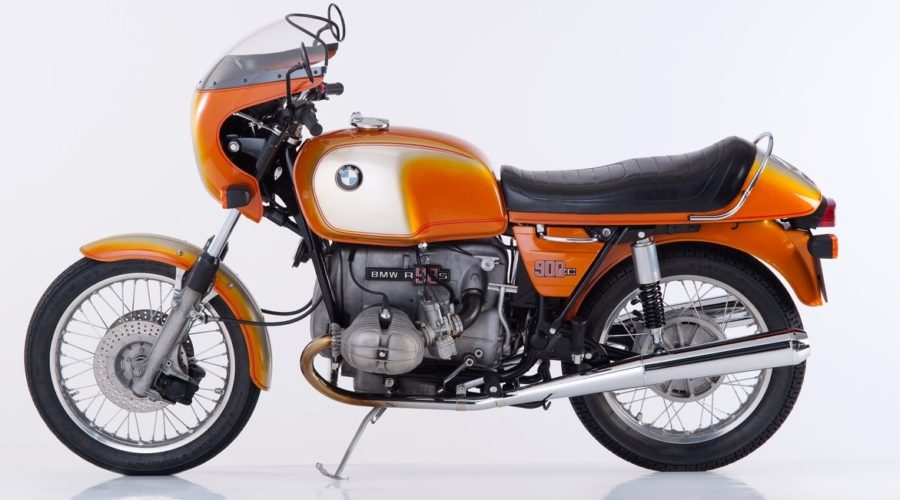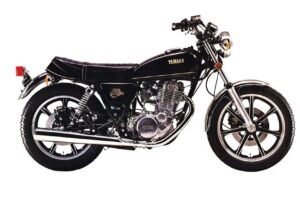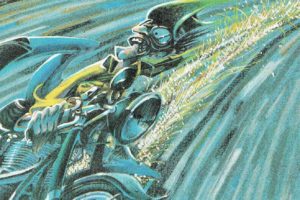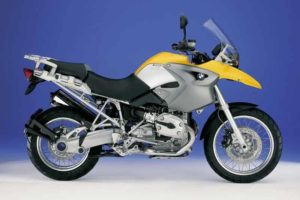1975 BMW R90S
There is universal agreement among motorcycle enthusiasts that the BMW is about the world’s finest motorcycle. The marque still seems to set a standard all but unapproachable by most makes and totally out of sight to others. And if the blue and white BMW nameplate guarantees something above and beyond the norm, then the top model in the three bike range ought to be the greatest thing built with a wheel on each end.
Two Wheels looked at the latest R90S sports tourer – almost a MkII version because of several detail changes – for justification of the legend.
The R90S combines beauty of design, stunning overall appearance, excellent – and mostly exclusive – appointments, complete instrumentation and reasonable outright performance.
It’s not the fastest on the road, nor does it accelerate anywhere near as dramatically as some. For that matter its engine is by no means as sophisticated as many and its exhaust note is hardly exciting.
But it combines so many virtues which are its own (and some other makers’) that it comes out in direct comparison with its contemporaries as something very special indeed.
Of course at a price close to four grand on the road and fully equipped, this thing ought to be out of sight! And it should stay there forever, because it would probably be the last machine a rider would buy after running the full gamut of a whole range of “ordinary” road irons.

The marque has always been exclusive, if only because of its price, and its sales have tended to be to the older enthusiast more able to afford it. As a result, BMW has not enjoyed much of a reputation for building roadburners – until recently that is, when the range was updated in the most radical way by a total change in design.
First of the all-new BMW range (then, as now, confined to just three variations of engine capacity on a common basic design) was introduced in 1969. The horizontally-opposed twin with shaft final drive concept remained, of course, for BMW has been committed to this design for 50 years. But the new unit was so radically different that only the rocker box caps were common to both designs and were totally interchangeable!
The range consisted of the previous capacity models of 500 and 600 cm3 but included BeeEmm’s first recognised superbike, the 750 cm3 tourer. Halfway through 1973 the German factory made a seemingly minor modification to the range when it endowed the marque with even better handling by increasing the wheelbase by just 5 cm. It achieved this feat by simply lengthening the machine’s swing arm by that amount and fitting a suitably longer Cardan drive-shaft.
At the same time, the factory also angled the carburettors more towards the engine castings to allow more room for taller riders’ shin bones, and cunningly concealed this by saying the extra legroom was made possible by the longer wheelbase. The ploy probably worked. At least one road-tester remarked that it was about time the Germans allowed more room between leg and inlet manifold, and applauded the longer wheelbase frame for achieving this end!
He also remarked that the factory claimed handling was unaffected by this important detail modification, and he agreed there was no discernible difference between pre- and post long wheelbase models.
How wrong he was! The modification was done in readiness for the belated arrival of the sports model – the all-new R90S.
The modification improved handling dramatically, not perhaps at the fairly reasonable speeds one would expect the “normal” BMW to be ridden, but at the top end of the machine’s performance where many of the owners (though perhaps not in Australia) might reasonably be expected to be riding. There were many rumours circulating at the time about a secret new model the Germans were soon to introduce to the Bee-Emm range, with speculation running rife about flat-fours, special overhead camshaft heads, 1000 cm3 engine capacities and more, much more.
When the news broke it was exciting enough, although for many it was something of an anti-climax because the new models continued to use the old-hat overhead valve engine; there wasn’t much of interest in that!

But there were radical changes for the Bavarian marque, because the factory had seen fit to follow fashion (which you could never accuse them of doing before) by fitting five-speed internals to their gearbox and introducing two 900 cm3 variants.
In doing so, the factory was forced to drop the smallest capacity model, the 500 cm3 R50. Its main disadvantage lay in the fact that it shared everything with its bigger brothers except engine capacity and performance. The device was only some 30 kg lighter than the bigger models! With the accent swinging very much towards superbikes and with BMW’s thinking enjoying the benefit of a new, young philosophy, there was no place in the range for the “small” 500.
And so the updated (you could hardly call it new) model was introduced at last, ending months of speculation as to just what exciting new things BMW had come up with for their new flagship.
Not everyone liked it; staunch “Boomer” fans decried the semicafe racer look of the sleek, low handlebar fairing and there were some who threw up their hands in horror at the indecently naked fork legs. Still others remarked on the gaudiness of the Christmas-tree dash panel.
But history tells the story very graphically, for such was the unprecedented demand for the new Bee-Emm flagship that we had to wait almost six months before the first of a thin trickle of R90S models reached Australia, to be snapped up eagerly by riders whose names had burned holes in dealers’ order books for months.
Cosmetically, the new sports mount was in there pitchin’ with the best of them, and the new paint job of black relieved by air-brushed silver smoke set off the promise of engine specifications in a most exciting way.
The later model has the same basic specifications as the first model, but is now available in a very smart so-called Daytona Orange (milky gold might be closer) as well as the original colour scheme. It also offers a totally new – and initially confusing – space-age switchgear and perforated brake discs. It is at once a very striking machine and one cast in the mould of an out-and-out sports model, its low, racy lines accentuated by perfect paintwork and gleaming chrome.
The frame is, of course,·trad black baked enamel, unique in using oval-section tubular steel. It uses full-cradle double-loop construction with closed ends and argon-arc welded bracing at major stress points around the steering head and swinging arm pivot points. The main tube is reinforced with a close-fitting round tube enclosed within its length. The box section frame is extremely rigid in all planes, but, sadly, has the rear sub-frame assembly bolted on just under the nose of the seat and above the pivot point for the swing arm.

The sub-frame forms the base for the dual seat and the top mounting point for the rear shock absorbers; it is hung cantilever-like from the two mounting points which, in themselves, are well triangulated, but there is no way in which a bolted-on rear assembly should be used on a motorcycle. It works perfectly well, but there is at least one instance known to this publication in which the bolts have worked loose in service. It was during a two-hour production race at the Calder Raceway in Melbourne, when Bob Rosenthal’s R90S was sidelined for several laps while replacements were found for a couple which had disappeared during the race!
Why, then, is the factory staying with this design?
We suspect it is to help defray the cost of replacing a damaged frame assembly. There can be no other justification. To be fair, there has been little trouble with bolted frames and BMWs are not the only examples of this design quirk. Perhaps in normal servicing a cautious owner should just give ’em the occasional tweak to check avoiding possible trouble?
Long-travel front forks boast 200 mm total movement and are of the fashionable exposed-tube pattern, with the lower sliders sealed by longer rubber sleeves than most. The sleeves include felt seals soaked in oil for automatic cleaning of the fork tubes. Two-way damping is (naturally) featured, BMW developing its own special damper fluid. The forks are fitted to the frame through a huge alloy bridge-piece, the centre stem pivoting on tapered roller bearings.
Hydraulically-operated twin discs are fitted to the front, the discs perforated to combat brake fade in the dry and moisture building in the wet. The caliper mounting bracket is cast as one piece with the lower fork slider and adds the bonus of extra rigidity to the fork itself. Cleverly, the brake fluid master cylinder is mounted on top of the crankcase under the fuel tank; nicely out of harm’s way, but it also means the tank has to be removed to inspect the cylinder.
Directly fitted to the handlebars is a prominent handlebar fairing which BMW refers to more accurately as a “cockpit” fairing. It dominates the front end of the machine, adding greatly to the overall sports image and dramatically reducing wind pressure.

But the appointments don’t end there, for the fairing also contains two instruments – a clock and matching voltmeter – fitted as standard equipment for the first time ever on a motorcycle. Also included are two very handy specification panels which list most of the essential data on tyre pressures, oil capacities, tappet settings, ignition timing and other information generally contained within the handbook you can’t find because Fred has borrowed it.
A dash panel is clamped to the top of the handlebars and sits in position below the lip of the fairing. The panel contains matching speedo and tacho, with a row of lights between them to indicate brake fluid level, neutral, battery charge, oil pressure and blinker. The main beam warning light is mounted in the rev counter which is redlined at 7200 rpm – and the speedo includes a trip meter. It has got to be the best dashboard setup around and that says a lot in view of some of the excellent Japanese designs.
The new switch gear almost warrants a report on its own. Initially confusing – which is odd because they are very well labelled – they are totally different from any on Japanese machines, including not only their operation but their positioning.
The right switch includes the starter button, a rocker blinker switch and a cut-out switch, while the left includes main light switch, horn button and a rocker switch for dipping the main beam. The handlebar clamp-cum-switch body is finished in matt black with clear white lettering, the cutout in a contrasting red and the main light switch in bright yellow. Very neat and easy to assimilate. Thankfully, the Germans have seen fit to run the wires neatly alongside the handlebars, ignoring the absurd Oriental – and sometimes Italian – practice of enclosing the wires within the bars themselves.
A sensibly-sized 24-litre fuel tank blends well with the long, contoured dual seat which swings up to uncover the large 12-volt battery. The battery sits under a moulded toolbox containing the world’s finest motorcycle toolkit, and your very own face-flannel with BMW woven into it! How pretentious, and yet how typical of a machine which is designed with so many little features built into it that it is damn near impossible to list them all.
Like the centrestand, which is so well positioned it holds the machine with either wheel clear of the ground. And the wheels are designed so you can remove them by merely loosening fork clamps. We found the wheels can each be removed in two minutes – and replaced without the need to line them up again. And there’s a tyre pump, which hides demurely away under the seat until needed, the prop stand which flicks up when the bike is lifted upright, and the three-position damper knob which locks the hydraulic steering damper in city, touring or road-burning positions!

The engine design is also such that routine maintenance is very simple. With the pots out in the breeze, good thermal efficiency is guaranteed, with tappet adjustments needing only the removal of a centre nut and two small “nuisance” anti-distortion studs to lift a rocker cover and expose the tappet screws. A huge casting on the front of the crankcase can be removed by unscrewing three captive Allan screws, uncovering the contact points, auto-advance unit and 280 Watt three-phase alternator mounted just inside.
A rubber bung on the side of the crankcase casting just above the left carburettor is lifted out when ignition timing has to be checked, and static setting can be determined by the time-honoured cigarettepaper-in-the-points-till-it-is-releasedas-they-open trick, or by strobe light if you must be like that. Similarly, the two Dell’Orto 38 mm carburettors hang out of the frame where they can be readily adjusted. In keeping with the sporting performance of the Bavarian twin, the carbs include large capacity float chambers and accelerator pumps.
Suitably long life for major engine components is ensured by adopting automotive practice in the design of the chunky one-piece forged crankshaft with massive bearing areas and plain bearings fed by a high-volume oil pump. A disposable oil filter element is fitted in the system, just above the wet-sump oil container which is a large neatly-finned pan bolted under the centre of the crankcases.
Bearing shells are the same size as the split plain bearings fitted to the BMW six-cylinder cars, so there should be little trouble with them. If they need to be replaced, the barrels are lifted merely by removing four nuts on the long through-bolts. The connecting rods can be dismantled without removing the engine from the frame! Likewise, the gearbox can be removed for servicing without disturbing the engine too much, although it’s a fairly major undertaking. Thankfully, the later BMW models have overcome the spate of gearbox problems which plagued the earlier five-speed boxes just after they were introduced.
It has been pointed out in detail, by many people who have probably never ridden one of the models, that the shaft-drive flat twin suffers from an unsettling torque reaction when braking, changing gear or backing off suddenly when cornering hard. Sounds logical enough, particularly as you can produce the reaction by tweaking the throttle while the machine is stationary; the bike does tend to flop over in such a situation. But that changes when the thing is mobile.

In fact, the only limiting factor on the machine under test was the crashbar, which wore itself down quite happily when we indulged in some pretty lurid cornering. It should be stressed this could only be done deliberately and on corners which we knew our way around pretty well. On the open road at any sort of speed there was no way they could be made to ground – and it seemed pointless to try!
The Dell’Orto cold-starting system uses a choke lever in the normal Bee-Emm position on the left of the crankcase near the nose of the seat, but differs in working more like an accelerator pump squirting the fuel in. It was necessary to close the control partly the moment the engine fired up, or uneven running would start almost immediately.
It idles with a degree of lumpiness, but becomes almost uncannily smooth the moment the throttle is opened and load applied. It remained smooth, except for a small vibration period at just on 4000 rpm, right through the range.
Another old characteristic of the BMW is its clunky gearchange. The new design gearbox has left this tradition far behind. You can poke the lever through the box as quick as you like on upward changes with no worries whatever, but a degree of patience is still needed when changing down again. The downward changes can be made with no protest from the gearbox once the correct drill is learned – and quickly too – but you must use the clutch at all times.
If you want to ride the R90S like an Oriental super-screamer there is nothing to stop you. Its acceleration is very useful indeed if its full potential is unleashed. But don’t be too dismayed to find the fleeter of the opposition’s heavyweights hosing off the German twin without too much trouble, because it doesn’t really shine in that department.
All you need to do is wait for the first set of bumpy curves to come rushing up to you and the boot is very much on the other foot. Here is one department in which the BMW does shine. The bike can be cranked over to some of the most improbable angles with little regard for road surfaces, and it will stick to a chosen line like lipstick to a singlet.
It has got to be one of the few machines which can be flung about almost willy-nilly; your line through a corner altered at will as you lift the bike slightly to blast round the outside of your quarry, or drop it over further to dive underneath. So much for your torque reaction.

Under brakes the bike’s directional stability is exceptional. The long, slow-travel forks and excellent three-way adjustable rear units soak up bumps almost as though they aren’t there, but the occasional deep dip can catch you unawares. It happened once and the bike seemed as though it wanted to wallow, but the moment the bike was dropped into the corner it settled down. It left the heightening impression that such a bump was more unsettling to the rider than the machine itself, and that it was he who had to settle down to the job.
One odd impression is generated by the overall line of the machine. The starter motor and air filter box are located within castings on top of the crankcase, the huge mass of alloy filling the entire area under the tank and apparently leaving no daylight between engine and frame tubes. This, allied to the tall, thin appearance of the rest of the bike and with the cylinders sticking out like a diner’s elbows, gives one the odd feeling of sitting on top of a pyramid. The impression belongs only to the R90S, for a quick burst on the other 900 cm3 variant, the R90/6, dispelled the feeling entirely.
Saddle height is high and the bars are flat, which adds to the sports appearance of the bike and certainly helps one to tuck in behind the fairing when things start to get busy at the top end of the machine’s performance (just over the metric double ton incidentally).
The seat is commendably wide and a little firmer than the earlier models adopted. The neatly streamlined tail contains a tiny “boot” in which the prudent owner may care to carry some small items of food to sustain him on the long trips he is bound to take on this easy road-burner.
In top gear the bike cruises perfectly happily at 120 km/h with just 4400 rpm on the clock, but it raps along just as happily half as quickly again – it just gets there sooner!
The exhaust is routed through a small coupling pipe which joins both outlets under the front of the crankcases, and it discharges through a pair of long, upswept slow-taper mufflers which burst ostentatiously from each side of the machine’s rear end. They are, of course, perfectly chromed and emit nothing more than an apologetic mutter at all stages of the bike’s performance range. They will disappoint those who wish to announce their rapid approach to all within a three-mile radius, but are to be commended for displaying how a machine can be at once a rapid projectile and yet be discreet about it.

The test machine was finished in the optional Daytona Orange, and was good-looking even when covered in a thin film of dust after one particularly long, hard squirt. It covered the long trip with ease and was totally free of any drama. In fact its performance was almost monotonous, for it did everything expected of it with no surprises,·
The only blot on the bike’s copy book could be the front edge of the exhaust pipes, which were a beautiful blue tapering to straw in the tradition of almost every bike that has gone before.
There were no oil leaks at engine, gearbox or drive shaft joints, which is as it should be. It’s comforting to know that the totally enclosed final-drive shaft allows maximum transmission lubrication without bathing the rear of the machine in oil or its rider’s coat in little black spots. The Cardan shaft is carried inside the right tube of the swing arm fork where it can be ignored, except for 10,000 km oil changes.
Oh, and what about the little holes in the side of the rear hub that let you check brake-shoe wear at a glance with the wheel still in the frame; and the fully adjustable pillion footrests? Think about the advantages of adjustable, tapered roller bearings for the swing arm pivot, and what about tank depressions for your knees to keep you in place under brakes and the totally logical fuel taps you can switch on in the dark without having to find where on and reserve are? How do you feel about …
It is only a natural reticence, tinged with a feeling for the fitness of things, which stops Two Wheels raving insufferably about the BMW sportster for it is very hard to fault and very easy to ride.
It isn’t perfect and it costs big money to put it on the road, but in this life you get only what you are willing to pay for. Or can afford.
By Lester Morris. Two Wheels, November 1975.

Ian Falloon has written the definitive model by model history of BMW, The Complete Book of BMW Motorcycles. Superbly illustrated with factory images, some of which Ian supplied for this test, and with every model covered in detail, it’s priced at $80 and available direct from Ian here.

Guido from AllMoto has the details on a Bonhams auction of classic BMWs, including an R90S, here.




